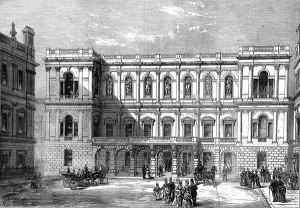Posts Tagged ‘Edinburgh’
Georgian Palladian
Palladian is the name given to style of architecture after the Venetian architect Andrea di Pietro della Gondola (1508-1580), more commonly known as Palladio, and derives from Palladio’s studies of Marcus Vitruvius Pollio (born c. 80–70 BC, died after c. 15 BC).
Palladio was a great fascination for the Original grand tourist Inigo Jones who brought the style to the Britain. Although few if Jones’s own designs were ever built: the Banqueting House (1622), Covent Garden (1630) and the Queens House Greenwich (1717). Whilst magnificent works, they did not create a fashion for the Palladian style, that was to come a century later.
The Georgian Palladian revival was instigated by Lord Burlington (1694-1753) and Colen Campbell (1676-1729). It then became the dominant British style for over two centuries; a feature of every high street, and the favoured style for many banks, public buildings and country houses. It was also adopted in the creation of spectacular city planning projects in Bath and Edinburgh.
Richard Boyle, 3rd Earl of Burlington, also known as ‘the Apollo of the Arts’ and ‘ the architect earl’, took three Grand Tours in Europe between 1714 – 1719 and a further trip to Paris in 1726. They gave him opportunities to develop his ‘taste’. His professional skill as an architect was unusual for an English aristocrat. He carried his copy of Andrea Palladio’s book I Quattro Libri dell’Architettura with him when touring in 1719, and made many notes and regords in it.
Burlington relied on Palladio, and Palladio’s pupil, Scamozzi as his interpreters of the classic tradition. He was also inspired by Palladio’s own drawings belonging to Inigo Jones, and to Jones’ pupil John Webb.
Burlington’s first project was his own London residence, Burlington House, now the Royal Academy of Art in Piccadilly, where he employed the Scottish architect Colen Campbell and William Kent for the interiors. Burlington House was the first major statement of Georgian Palladianism to be executed in Britain.
Colen Campbell had travelled in Italy from 1695-1702 and later published, Vitruvius Britannicus (the British Architect), in three volumes between 1715 and 1725; a catalogue of design, containing engravings of English buildings by Inigo Jones and Sir Christopher Wren, as well as Campbell himself and other prominent architects of the period.
Their success made the neo-Palladian Architecture popular in Great Britain and America during the 18th century. For example, an illustration of Somerset House was an inspiration for the American architect Peter Harrison when he designed the Brick Market in Newport, Rhode Island, in 1761.
By the early 1730s Palladian style was firmly established. Having been adopted by the Italian gentry as town and country villas. The concepts were adaptable and scalable making them appropriate for many private and public uses in Britain.




